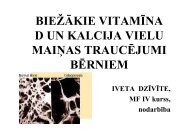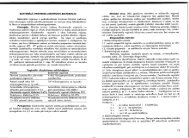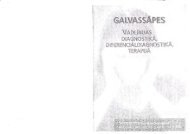PHYSICS
n - susliks.lv
n - susliks.lv
- No tags were found...
Create successful ePaper yourself
Turn your PDF publications into a flip-book with our unique Google optimized e-Paper software.
treatment of inflammatory, degenerative and dystrophic diseases,<br />
such as trophic and indolent wounds, burns, injuries to tendons<br />
and bones, arthritis, and gastric ulcers. The effects of red radiation<br />
on the inflammatory processes, neuro-endocrine and nervous<br />
systems, metabolism, bioelectric activity of organism, hematologic<br />
parameters, and bone regeneration are excellent<br />
examples of the use of laser phototherapy in animals. However, it<br />
is necessary to note that specific parameters of laser radiation<br />
(coherence, monochromaticity, polarization) do not appear to<br />
be important. As a consequence, red light phototherapy can be<br />
considered as usual photobiological phenomenon.<br />
Laser Photochemotherapy. This photomedical technique is based<br />
on the ability of the photosensitizer to accumulate and be selectively<br />
retained in malignant tissue to a greater degree than in normal<br />
tissue. As a consequence, laser irradiation can be used to preferentially<br />
destroy tumors. Laser photochemotherapy involves the<br />
injection of a photosensitizer and after an appropriate incubation<br />
period, illumination of the malignant tissue with laser radiation<br />
(48 - 72 hours). The photosensitizer absorbs sufficient light energy<br />
to shift the molecule from the singlet to a tri plet state. The<br />
excited triplet state photosensitizer then produces either free<br />
radicals or singlet oxygen that oxidatively disrupt the cells in malignant<br />
tissue causing necrosis and death. Photosensitizers commonly<br />
employed in the laser photochemotherapy of the malignant<br />
tumors are hematoporphyrin derivatives (HpD). Secondary<br />
effects of HpD include edema and sunburn of the skin if the<br />
patient is exposed to excessive sunlight. The development of new<br />
photosensitizers without adverse side-effects represents an important<br />
research topic.<br />
Laser Acupuncture. The ability of laser radiation to penetrate<br />
tissues allows it to be used for acupuncture - a medical procedure<br />
that involves the stimulation of biologically active points on<br />
the surface of the body. An example of the positioning of the<br />
acupoints on an animal is presented in fig. 23.4. The advantages<br />
lasers confer to acupuncture are that it is non-invasive, rapid,<br />
aseptic, and painless. Typical acupuncture parameters for laser<br />
radiation are a 1 - 2 mm diameter laser beam and a radiation intensity<br />
of about 1 - 5 mw/cm". Usually an optical system (laser<br />
and fiber) is used in conjunction with an electrical system that<br />
Fig. 23.4. The typical picture of acupoints of the animal<br />
monitors skin resistance to indicate the appropriate positions for<br />
the acupoints. Changes in resistance are indicated by a sound or<br />
light signal. The duration of the laser radiation treatment is for a<br />
relatively precise time interval. Treatment effects on animals include<br />
increased phagocytosis, tissue granulation, stimulated collagen<br />
synthesis, vascularisation, acetylcholine release, production<br />
of T- and fj-lymphocytes, increased serotonin synthesis, inhibition<br />
of prostaglandin effects in the tissue, stimulation and release<br />
of fj-endorphins, and increased synthesis of ketosteroids and hydroxycorticosteroids.<br />
The adoption of laser acupuncture remains a subject of debate<br />
with the advantages of the procedure being touted by supporters<br />
and the deficiencies by opponents.<br />
178 179






